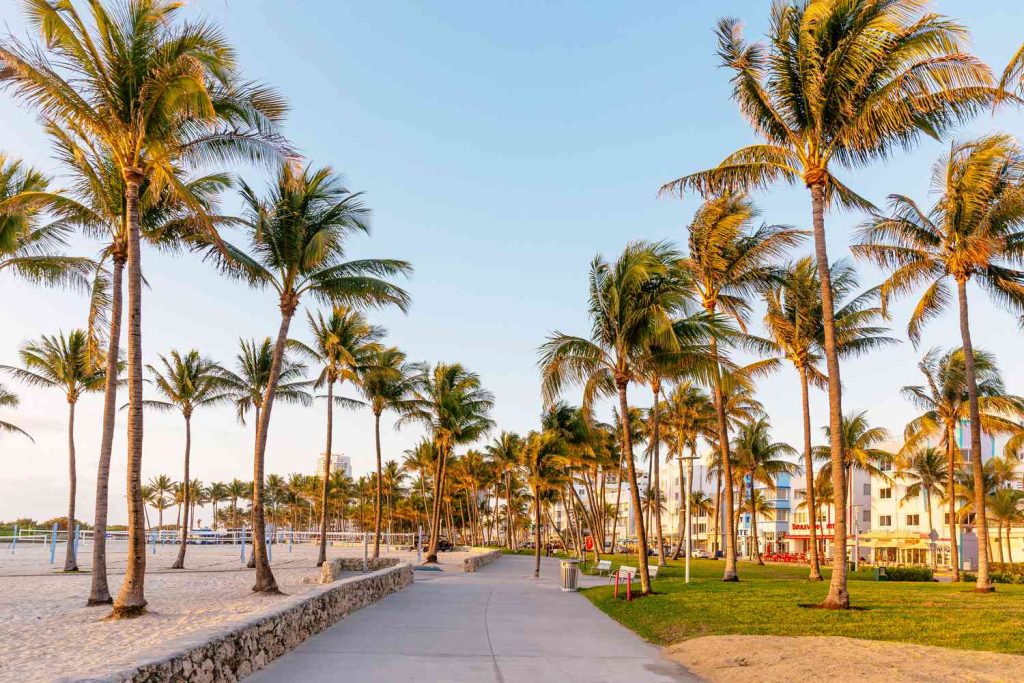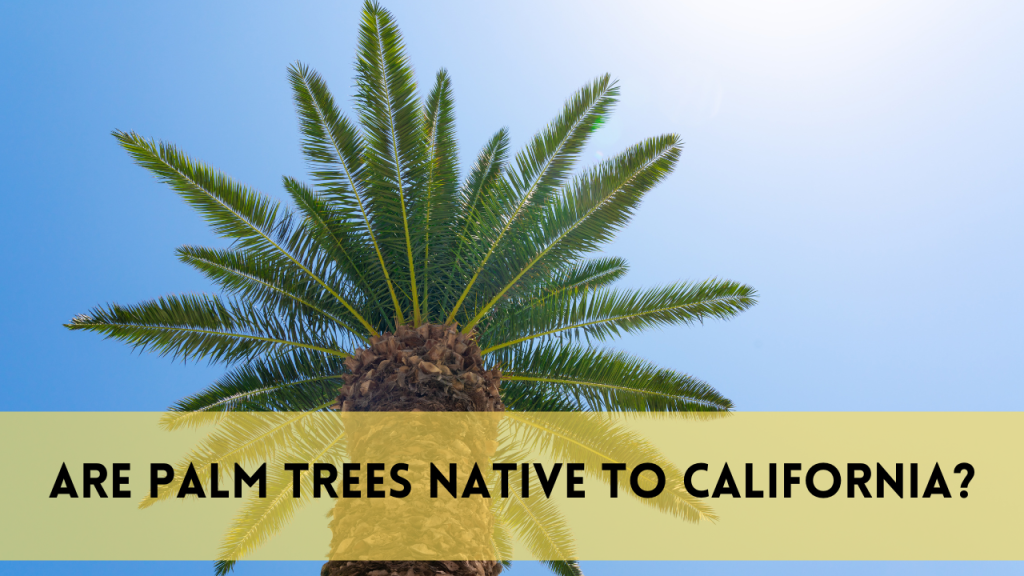Are palm trees native to Florida?
People often associate palm trees with the picturesque landscapes of Florida, as their towering fronds gently sway in the warm breeze. However, the question arises: are palm trees native to Florida? This investigation examines the botanical origins of these iconic trees, identifying the native species and those introduced over time.
Are palm trees native to Florida?
Some palm trees are native to Florida but some are non-native to Florida. Here are the native and non-native palm trees in Florida.
Native Palm Trees of Florida
Florida is home to natural palm trees that have adapted to flourish in its peculiar climate. Listed below are some of the more notable species:
Sabal palm (Sabal palmetto)
The Sabal Palm, also called the Cabbage Palm, is Florida’s official tree. It is recognizable by its thick, unbranched trunk and broad, fan-shaped fronds. Fragments of old leaf bases generally coat the trunk, giving it a rough appearance. Sabal palms are extremely versatile, growing in a wide range of settings, from coastal dunes to inland forests and wetlands. They grow in sandy soils and are tolerant of sea spray, making them widespread along the coast.

Native Americans and early immigrants ate the heart of the Sabal Palm, historically known as the “cabbage.” The tree is now highly regarded in landscaping due to its durability and iconic beauty.
Saw palmetto (Serenoa repens)
The saw palmetto is a low-growing, clumping palm with creeping, horizontal stems. Its fronds are fan-shaped and have sharp, serrated edges, hence the name “Saw Palmetto.” Pine flatwoods, coastal areas, and scrub habitats throughout Florida frequently host this palm. It prefers well-drained, sandy soils and can grow dense thickets that are difficult to penetrate. Saw palmetto berries are an important food source for wildlife, including the endangered Florida black bear and many bird species. The dense thickets make excellent cover for animals. The berries are well-known for their medical benefits, particularly in the treatment of prostate disorders. Aside from its ecological value, saw palmetto is utilized in landscaping for its ground cover and drought resistance. We gather the berries for supplementation and herbal medicine.
Royal Palms (Roystonea regia)
The Royal Palm is one of Florida’s most majestic native palms, distinguished by its tall, smooth, and slightly swollen trunk that can reach heights of up to 80 feet. The fronds are long, feathery, and arching, lending the tree a regal appearance.
Southern Florida, particularly the Everglades and the coast, is the primary home of royal palms. Often found near water sources, they thrive in moist, well-drained soils.
The Royal Palm provides habitat and food for various birds and insects. Wildlife consumes the fruit, while the large fronds offer shade and shelter. The tree’s presence in the ecosystem helps to preserve local biodiversity.
People commonly use the Royal Palm in landscaping, especially in urban areas and along streets, due to its striking beauty. Parks and gardens also plant it because of its aesthetic value.
Florida Thatch Palms (Thrinax radiata)
This palm is native to Florida’s southern coastal regions, including the Florida Keys. It is well-suited to sandy soils and can withstand salt spray, making it a hardy species in coastal areas. The Florida Thatch Palm is a tiny palm that grows to heights of 10 to 20 feet. It has slender trunks and coastal leaves in fan and feather forms. The Florida thatch palm provides a valuable habitat for coastal species. Its seeds and flowers attract birds and insects, while its leaves provide nesting locations. The palm helps stabilize sandy soils and prevent erosion.
Landscapers prize the Florida thatch palm for its ability to thrive in challenging coastal environments. It’s commonly employed in beachfront gardening and coastal rehabilitation initiatives.
Florida’s non-native palm trees
In addition to its native species, Florida is home to a diverse range of non-native palms transplanted from other locations. These palms have grown popular in landscaping, adding to Florida’s tropical environment.
Coconut Palm (Cocos Nucifera)
The coconut palm is undoubtedly the most distinctive tropical palm, characterized by its tall, slender trunk and clusters of coconuts. Despite not being native to Florida, the coconut palm flourishes in the state’s warm climate and sandy soils. Early inhabitants and traders are believed to have brought it to Florida.
Queen Palm (Syagrus Romanzoffiana)
The Queen Palm originated in South America and has become a popular decorative tree in Florida due to its graceful beauty and ease of care. Residential and commercial landscaping often utilizes the Queen Palm due to its arching fronds and modest height.
Date Palm (Phoenix Dactylifera)
Native to the Middle East and North Africa, the date palm is known for its sweet fruit, but Florida has grown it for many years. Landscapes and gardens commonly employ date palms for their aesthetic appeal, creating an air of exotic elegance.
The role of palm trees in the Florida ecosystem
Palm trees, native and non-native, play an important role in Florida’s ecosystem. They provide shelter and food for a diverse range of animals, including birds, insects, and small mammals. The vast range of palm species promotes ecological equilibrium in a variety of settings, including coastal dunes and inland woodlands.
Wildlife Habitat
Native palms, such as the Saw Palmetto and Sabal Palm, provide critical habitat and nesting grounds for wildlife. These palm berries are an important food source for birds and other animals. For example, the Florida Scrub Jay, an endangered species, depends on saw palmetto for food and shelter.
Erosion Control
Palm trees are also important for preventing erosion along Florida’s coasts. Large root systems in palm trees help anchor the soil and prevent erosion from wind and water. This is especially crucial for shielding coastal areas from the effects of hurricanes and tropical storms.
Cultural and economic importance
Palm trees have important cultural and economic significance in Florida. They are a representation of the state’s tropical paradise image, drawing both tourists and new residents. The landscaping industry is primarily reliant on diverse palm species to generate the lush, tropical landscapes synonymous with Florida’s beauty.
Related Posts:
Conservation efforts and challenges
Despite their importance, Florida’s native palms face numerous threats, including habitat loss, invasive species, and disease. Conservation efforts are critical for protecting these precious trees and the ecosystems they sustain.
Habitat Loss
Urbanization and agricultural expansion have resulted in the loss of natural habitats for many native palm species. Protecting and restoring these habitats is critical for the survival of native palms and the fauna that lives in them.
Invasive species
Invasive plant species, such as Australian Pine and Brazilian Pepper Tree, compete with native palms for resources and space. Managing and eradicating invasive species is an important part of conservation efforts.
Diseases and pests
Palm trees in Florida are susceptible to various diseases and pests, such as lethal yellowing and palm weevils. Monitoring and mitigating these challenges is critical for maintaining healthy palm populations.
FAQS
Are all palm trees native to Florida?
No, not every palm tree in Florida is native. Although some native species exist in the state, many palm trees in Florida are transplanted from other locations.
How can we help preserve Florida’s native palm trees?
Natural habitat protection, invasive species management, tree health monitoring, and restoration project support are all examples of conservation initiatives. Public awareness and participation in these initiatives are critical to the conservation of native palms.
Why are palm trees useful for erosion control?
Large root systems of palm trees aid in soil maintenance, preventing erosion from wind and water. This is especially significant in safeguarding coastal regions from the effects of hurricanes and tropical cyclones.
What are the economic implications of palm trees in Florida?
Palm trees make a significant contribution to Florida’s economy by improving the state’s tropical image, attracting tourists, and sustaining the landscaping business. They play an important role in establishing the lush, tropical landscapes that define Florida’s allure.
Conclusion
In conclusion, not all palm trees in Florida are native to the state. Native species such as the Sabal Palm, Saw Palmetto, Royal Palm, and Florida Thatch Palm are vital to Florida’s natural landscapes and ecosystems. Non-native species, including the coconut palm, queen palm, and date palm, have also become major aspects of the state’s landscape. Understanding the origins and functions of these palm trees emphasizes the necessity of protecting Florida’s native species while appreciating the beauty and diversity that non-native palms provide. Efforts to maintain and sustain these trees are critical to preserving Florida’s distinctive environmental heritage.




